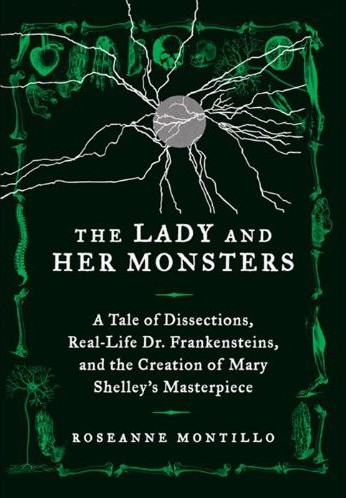 In “The Lady and Her Monsters,”Roseanne Montillo forays into 19th century Europe, telling of the many forces, cultural, scientific, and personal, that gave rise to Mary Shelley’s “Frankenstein.”
In “The Lady and Her Monsters,”Roseanne Montillo forays into 19th century Europe, telling of the many forces, cultural, scientific, and personal, that gave rise to Mary Shelley’s “Frankenstein.”
Montillo’s work weaves between two narratives, one pertaining to Shelley’s life and the other pertaining to the scientific developments of the era. The scientific portion emphasizes developments within the fields of galvanization and anatomy.
Montillo commences with an account of Luigi Galvani’s famed experiment, in which he skewered dead frogs using metal hooks to a balcony’s iron railings.
Galvani, enthralled, watched as the frogs twitched with every strike of lightening. Although it would later be discovered that the frogs’ “movements” were really the movements of the nails that pierced them, Galvani’s intrigue would inspire Giovanni Aldini, his nephew, who, like Victor Frankenstein, attempted to reanimate a corpse.
Perhaps the most valuable part of Montillo’s narrative is the detail she gives to Shelley’s life. Just as her protagonist Victor Frankenstein flaunted society’s norms, so did Shelley (née Godwin). Much to her father and stepmother’s dismay, Godwin pursued a romantic relationship with the married poet Percy Bysshe Shelley .
It was during one of her trips, to the German town of Burg Frankenstein, where Godwin most likely heard of the legendary Johann Conrad Dippel, a fictional inhabitant. Due to his carelessness and ignorance, Dippel’s lab caught on fire, and he subsequently lost his knowledge of the transmutation of lead. Such a narrative inveighing against the vices of hubris and carelessness almost seems to presage that of “Frankenstein,” and makes the origin of Victor’s surname obvious.
When forced inside by the weather during a stay at Lord Byron’s Villa Diodati, located on the shores of Lake Geneva, Godwin soon became an active listener to the back-and-forth between Percy and John Polidori, Byron’s personal doctor. Polidori, a recent graduate of Edinburgh Medical School, would have been well-versed in the subject of anatomy and body snatching as well, the latter a recurring topic in “The Lady and Her Monsters.”
The greatest flaws in “The Lady and Her Monsters” lie in Montillo’s going off on tangents pertaining to Lord Byron’s private life, and Montillo’s transitions between her two storylines are occasionally abrupt.
However, the vivid detail Montillo provides when describing developments in the field of anatomy, as well as her description of “resurrectionists” make this nonfiction book a per-fect read for anyone enthralled by “Frankenstein”s scientific underpinnings or frightening tales in general.
(This article originally appeared in the February 28, 2013 print edition.)

